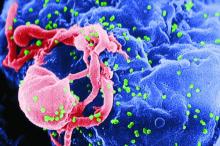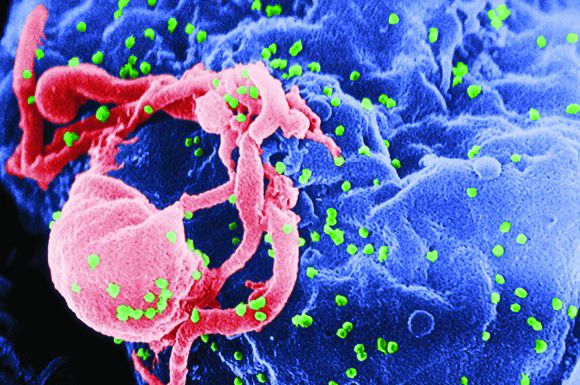User login
Certain species of vaginal bacteria rapidly metabolized topical tenofovir, which was three times less effective at preventing HIV in women with predominantly these vaginal microbiota, according to results of a study published in Science.
Key culprits were Gardnerella vaginalis and other anaerobic species associated with bacterial vaginosis, reported Nichole R. Klatt, PhD, of the University of Washington, Seattle, and her associates. The findings could help explain the lower and widely variable efficacy rates of topical microbicides in clinical HIV prevention trials, they added.
Lactobacillus was the primary genus in 423 women (62%), while non-Lactobacillus microbiota predominated in the remaining 256 women. Compared with placebo, tenofovir decreased the incidence of HIV infections by 61% (95% confidence interval, 0.16-0.89; P = .01) in women whose vaginal microbiota consisted mainly of Lactobacillus species, but by only 18% (95% CI, 0.37-1.77; P = .6) when nonlactobacilli predominated. These findings did not change after the investigators controlled for sexually transmitted infections, use of antibiotics, use of depot medroxyprogesterone acetate (DMPA), and sexual behaviors (including frequency of sex, number of partners, and condom use). Furthermore, the two groups were clinically, behaviorally, and demographically similar and had similar rates of adherence to tenofovir gel during the trial.
The non-Lactobacillus group had more bacterial diversity and several distinct subgroups, the largest of which was dominated by Gardnerella vaginalis and other bacteria associated with bacterial vaginosis. This subgroup had lower mucosal levels of tenofovir, compared with women with primarily lactobacilli, the investigators reported. Tenofovir concentrations fell by 51% in the in vivo cultures of G. vaginalis but dropped only slightly in cultures of two common Lactobacillus species (P less than .004 for each comparison). After 24 hours, tenofovir concentrations had decreased by 67% in cultures with G. vaginalis but by only 9%-14% in cultures with lactobacilli.
The researchers also tested three other subtypes of G. vaginalis, all of which metabolized tenofovir. The findings revealed a biologic mechanism that is probably part of “a multifactorial process, including increased vaginal inflammation and adherence, leading to varying levels of HIV prevention efficacy observed across topical microbicide trials,” they concluded. Screening by testing vaginal pH or microbiota might help “guide and enhance prevention of HIV in women,” they wrote.
Funders included the Canadian Institutes of Health Research, the University of Washington, the Public Health Agency of Canada, and the U.S. Agency for International Development. The investigators had no disclosures.
Certain species of vaginal bacteria rapidly metabolized topical tenofovir, which was three times less effective at preventing HIV in women with predominantly these vaginal microbiota, according to results of a study published in Science.
Key culprits were Gardnerella vaginalis and other anaerobic species associated with bacterial vaginosis, reported Nichole R. Klatt, PhD, of the University of Washington, Seattle, and her associates. The findings could help explain the lower and widely variable efficacy rates of topical microbicides in clinical HIV prevention trials, they added.
Lactobacillus was the primary genus in 423 women (62%), while non-Lactobacillus microbiota predominated in the remaining 256 women. Compared with placebo, tenofovir decreased the incidence of HIV infections by 61% (95% confidence interval, 0.16-0.89; P = .01) in women whose vaginal microbiota consisted mainly of Lactobacillus species, but by only 18% (95% CI, 0.37-1.77; P = .6) when nonlactobacilli predominated. These findings did not change after the investigators controlled for sexually transmitted infections, use of antibiotics, use of depot medroxyprogesterone acetate (DMPA), and sexual behaviors (including frequency of sex, number of partners, and condom use). Furthermore, the two groups were clinically, behaviorally, and demographically similar and had similar rates of adherence to tenofovir gel during the trial.
The non-Lactobacillus group had more bacterial diversity and several distinct subgroups, the largest of which was dominated by Gardnerella vaginalis and other bacteria associated with bacterial vaginosis. This subgroup had lower mucosal levels of tenofovir, compared with women with primarily lactobacilli, the investigators reported. Tenofovir concentrations fell by 51% in the in vivo cultures of G. vaginalis but dropped only slightly in cultures of two common Lactobacillus species (P less than .004 for each comparison). After 24 hours, tenofovir concentrations had decreased by 67% in cultures with G. vaginalis but by only 9%-14% in cultures with lactobacilli.
The researchers also tested three other subtypes of G. vaginalis, all of which metabolized tenofovir. The findings revealed a biologic mechanism that is probably part of “a multifactorial process, including increased vaginal inflammation and adherence, leading to varying levels of HIV prevention efficacy observed across topical microbicide trials,” they concluded. Screening by testing vaginal pH or microbiota might help “guide and enhance prevention of HIV in women,” they wrote.
Funders included the Canadian Institutes of Health Research, the University of Washington, the Public Health Agency of Canada, and the U.S. Agency for International Development. The investigators had no disclosures.
Certain species of vaginal bacteria rapidly metabolized topical tenofovir, which was three times less effective at preventing HIV in women with predominantly these vaginal microbiota, according to results of a study published in Science.
Key culprits were Gardnerella vaginalis and other anaerobic species associated with bacterial vaginosis, reported Nichole R. Klatt, PhD, of the University of Washington, Seattle, and her associates. The findings could help explain the lower and widely variable efficacy rates of topical microbicides in clinical HIV prevention trials, they added.
Lactobacillus was the primary genus in 423 women (62%), while non-Lactobacillus microbiota predominated in the remaining 256 women. Compared with placebo, tenofovir decreased the incidence of HIV infections by 61% (95% confidence interval, 0.16-0.89; P = .01) in women whose vaginal microbiota consisted mainly of Lactobacillus species, but by only 18% (95% CI, 0.37-1.77; P = .6) when nonlactobacilli predominated. These findings did not change after the investigators controlled for sexually transmitted infections, use of antibiotics, use of depot medroxyprogesterone acetate (DMPA), and sexual behaviors (including frequency of sex, number of partners, and condom use). Furthermore, the two groups were clinically, behaviorally, and demographically similar and had similar rates of adherence to tenofovir gel during the trial.
The non-Lactobacillus group had more bacterial diversity and several distinct subgroups, the largest of which was dominated by Gardnerella vaginalis and other bacteria associated with bacterial vaginosis. This subgroup had lower mucosal levels of tenofovir, compared with women with primarily lactobacilli, the investigators reported. Tenofovir concentrations fell by 51% in the in vivo cultures of G. vaginalis but dropped only slightly in cultures of two common Lactobacillus species (P less than .004 for each comparison). After 24 hours, tenofovir concentrations had decreased by 67% in cultures with G. vaginalis but by only 9%-14% in cultures with lactobacilli.
The researchers also tested three other subtypes of G. vaginalis, all of which metabolized tenofovir. The findings revealed a biologic mechanism that is probably part of “a multifactorial process, including increased vaginal inflammation and adherence, leading to varying levels of HIV prevention efficacy observed across topical microbicide trials,” they concluded. Screening by testing vaginal pH or microbiota might help “guide and enhance prevention of HIV in women,” they wrote.
Funders included the Canadian Institutes of Health Research, the University of Washington, the Public Health Agency of Canada, and the U.S. Agency for International Development. The investigators had no disclosures.
FROM SCIENCE
Key clinical point: Certain species of vaginal bacteria rapidly metabolized topical tenofovir.
Major finding: After 24 hours in culture, tenofovir concentrations had decreased by 67% in cultures with Gardnerella vaginalis but by only 9%-14% in culture with lactobacilli.
Data source: Mass spectrometry–based proteomics of vaginal specimens from 668 HIV-negative women.
Disclosures: Funders included the Canadian Institutes of Health Research, the University of Washington, the Public Health Agency of Canada, and the U.S. Agency for International Development. The investigators had no disclosures.

